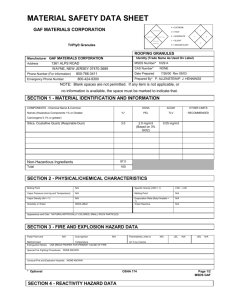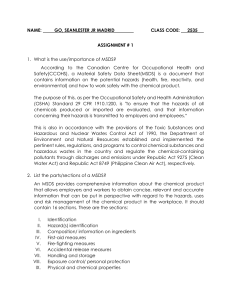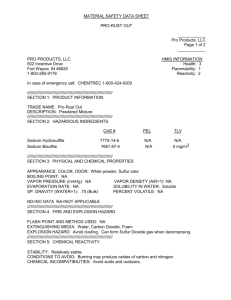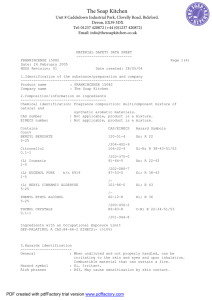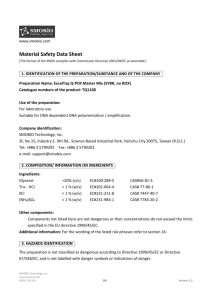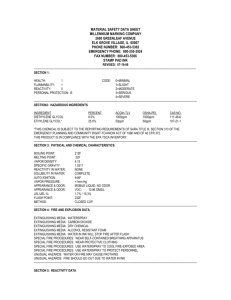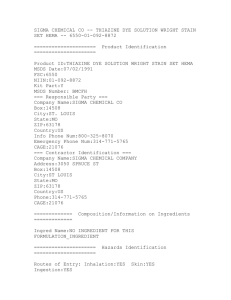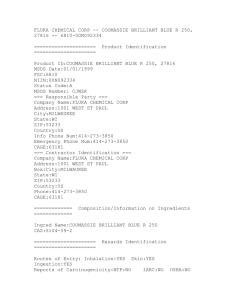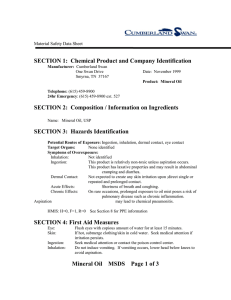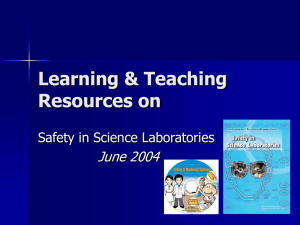Material Safety Data Sheets (MSDS)
advertisement
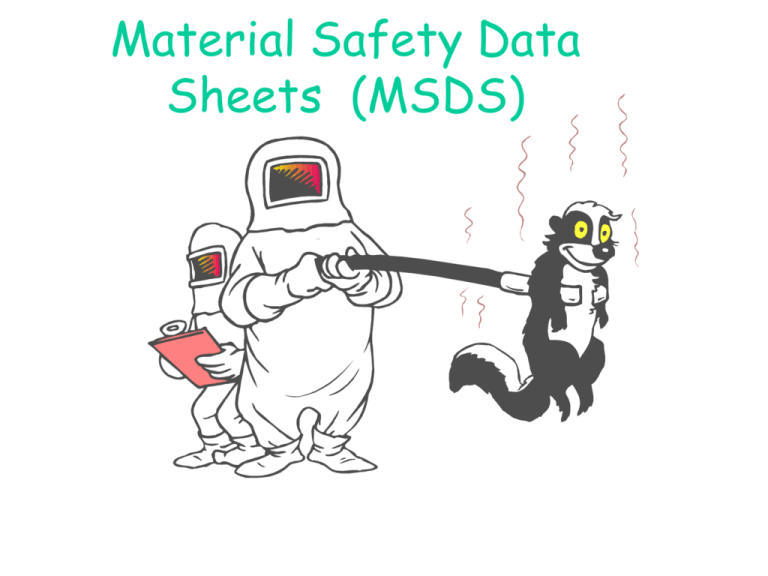
Material Safety Data Sheets (MSDS) Material Safety Data Sheets • Are to be provided by Supplier’s with all deliveries • MUST be Accessible to EVERYONE in the workplace • Must be current • Must be made available to attending physician in the event of exposure DEFINITIONS • Flammable: ANY substance easily ignited and quick burning, including liquids with a flash point below 95 degrees Fahrenheit. • Toxic: ANY substance (alone or via chemical reaction) able to cause harm/produce injury to the body through absorption, ingestion, inhalation, or injection. • Caustic: ANY substance able to burn, damage or destroy organic tissue by chemical reaction; Corrosive. Definition cont’d • Flash point--the lowest temperature at which a liquid produces enough vapor to ignite. • Density--(% of Water & Air); Specific Gravity Definition cont’d • PEL–-Permissible Exposure Limit is the standard recognized by industry as the maximum amount or concentration of a chemical that a worker may be exposed to. • TLV—Threshold Limit Value is a recommended limit for chemical substance exposures, similar to the PEL but most often more restrictive than the PEL. • TWA–-an 8-hour Time-Weighted Average is the concentration the average worker can be exposed during an 8-hour workday, day after day, without harmful effects. • STEL— “Short Term Exposure Limit” is a 15 minute period. • Ceiling—the maximum (C) concentration never to be exceeded. Definition cont’d • Lethal Dose50 (LD50) is the amount of a substance that, when administered by a defined route of entry (e.g. oral or dermal) over a specified period of time, is expected to cause the death of 50% of a defined animal population. Definition cont’d • Lethal Concentration50 (LC50) is the amount of a substance in air that, when given by inhalation over a specified period of time, is expected to cause the death in 50% of a defined animal population. READING THE MSDS Identity The chemical name, trade name and manufacturers name, address and emergency phone number can be found here. – Ingredients Includes: substance, % content, CAS Number, Classification, EINECS – Hazards Identification Dangers for humans and the environment such as: Most important hazards & Specific hazards First Aid gives instructions on what to do in case of eye contact, skin contact or ingestion READING THE MSDS cont’d – Fire Fighting Suitable extinguishing media, Unsuitable extinguishing media, Special hazards in fire, Required special protective equipment for fire-fighters Accidental Release Measures/Spill Clean-up Personal precautions, Environmental precautions, Methods for cleaning Handling and Storage Exposure Controls and Personal Protection Information on proper PPE to use, how to store and temperature limits READING THE MSDS cont’d – Physical and Chemical Properties Appearance, Odor, pH, Boiling point, Melting point, Flashpoint, Explosive properties, Vapor pressure, Relative density, Solubility – Stability and Reactivity Conditions to avoid, Materials to avoid, Hazardous decomposition products – Toxicology Acute toxicity, Local effects. Excessive exposure may affect human health as follows: Skin contact, Eye contact, Inhalation/ingestion. – Ecological Information Lists any dangers to the environment Disposal Lists any special disposal methods Reading the MSDS cont’d Transport Information lists codes indicating the dangers and the type of transport which may be needed Regulations Lists any agency that may regulate this product – Other Information Recommendations/restrictions, Sources of key data used to compile Safety Data Sheet
